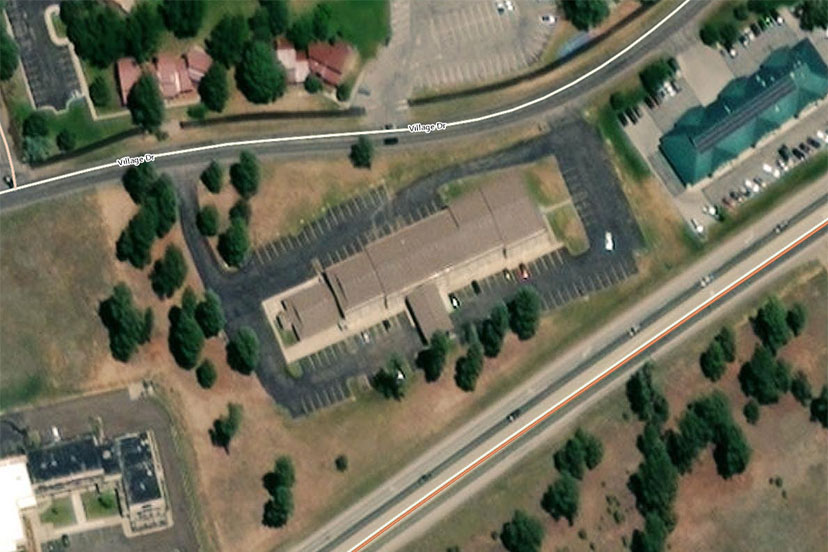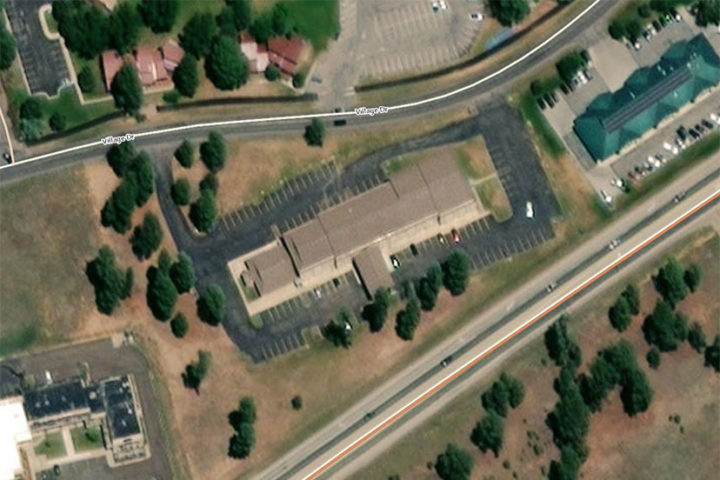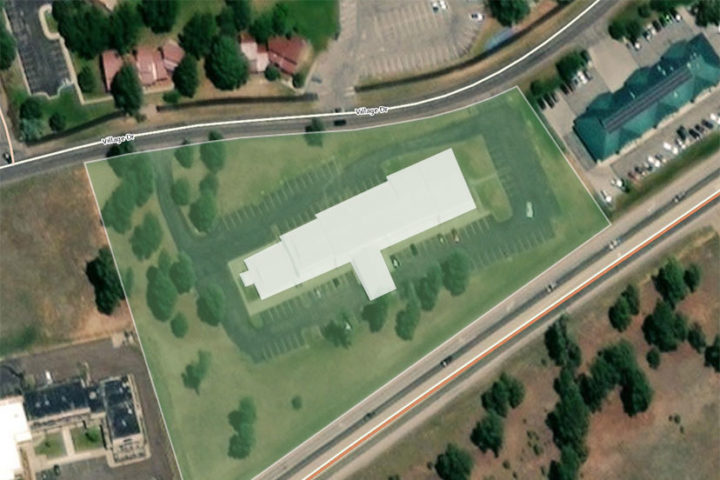It’s a fine thing, for Pagosa Housing Partners to run a survey and collect some data. But it’s a useless exercise unless our community leaders can use the data to lead us into a better situation.
I hope that will happen. There many way to address a crisis, once it gets defined.
We’ve talked a little bit about ‘zoning’ in relation to the proposed conversion of the Pagosa Springs Inn & Suites into a 98-unit apartment building. I’ve also suggested that our local government — with the best of intentions — has put the supposed “free market” of housing into a minimum-security prison, from which escape will be difficult.
Let’s take a bird’s eye view of the problem. Here’s the Pagosa Springs Inn & Suites, seen from above.
This motel property, like several other motel properties in Archuleta County, was annexed into the Town of Pagosa Springs in the 1990s, as part of a move by the Town government to bring the lion’s share of sales-tax-generating businesses within the municipal limits. I don’t know the exact percentage of community-wide sales tax that now gets generated from within the Town limits (does anyone?) but I am guessing it’s in the 90% range.
This means that any changes to the Pagosa Springs Inn & Suites property can be — and are — controlled by the Town of Pagosa Springs Land Use and Development Code (LUDC).
Severely controlled, in some situation. Not “free”, as in “free to develop as the owner wishes.”
The properties immediately north of the motel, in the top left of the image above, are outside the municipal limits, and are not subject to the Town’s LUDC regulations. But they’re subject to control by the County government, and by a property owners association. Again, not “free”.
Looking at the aerial view with a couple of colored overlays can help make the effects of these controlling regulations more obvious.
The white shape indicates the actual motel building. with a footprint of about 1/2 acre. The pale green indicates the parcel, measuring about 4.12 acres. It’s not intuitively obvious, perhaps, that you could theoretically fit eight 1/2-acre buildings on this parcel, with some room left over. But the Town government requires a parking space for each motel room. So this 1/2-acre building is surrounded by 1.3 acres of parking spaces.
Because of the parking requirements — and landscaping requirements — the Town regulations would never allow eight motels to occupy this parcel. So in a sense, the owners of this private property is rather severely limited in the use of their own property.
The Town has now been presented a proposal to convert this motel into a 98-unit apartment building, but the Town’s zoning rules allow only 16 units per acre in this zoning district. So, according to the LUDC, the owners of this private property are allowed only 66 apartments, meaning they would potentially need to leave 1/3 of the building vacant.
Does this rule make any sense? It certainly seems to make zero sense to me, if we are trying to encourage a variety of housing options to promote community diversity. Who decided that building more than ’16 units per acres’ on the ‘Mixed-Use Corridor’ zoning district was somehow dangerous to the community’s welfare? Someone did, but I have no idea who.
Then we have an interesting development that took place over the past few weeks. The Town Planning Department developed a brand new policy — a ‘density bonus’ policy — that allows the Pagosa Springs Inn & Suites (and anyone else) to increase their allowed number of dwelling units by 50% above the zoning limit, if the property owner is willing to rent out 25% of its total units as ‘workforce housing’ for at least seven years.
The density bonus lasts forever, but the promise of workforce housing can expire in seven years.
Anyone who has been following the Daily Post over the past decade knows that I view affordable housing as the key crisis unfolding in Archuleta County, and that the crisis is growing more severe with each passing day. So it might seem reasonable that I would approve of the Town’s density bonus policy.
In fact, I disagree with this policy, for a few reasons. First of all, the policy assumes that limiting housing units within the ‘MU-C’ zoning district to 16 units per acre makes some kind of rational sense. As I just mentioned, the existing Pagosa Springs Inn & Suites has a footprint of 1/2 acre. Within that 1/2 acre, they managed to fit almost 100 dwelling units — which are currently motel rooms, but which the Town Planning Department now suggests can be converted into apartments.
Do the math. That means the motel itself currently has an occupancy density of 200 units per acre. Even if you include the parking lot as something necessary, the density is 50 units per acre.
Has anyone been harmed — over the past two decades — by having a building with a density of 200 units per acre (or alternately, 50 units per acre) sitting in a prominent location within walking distance of the City Market Shopping Center? I think not.
But the Town LUDC specifically states that a density of more than 16 dwelling units per acre cannot be allowed… unless we bend the rules with a special policy, to allow 24 units per acre; something the Town Planning Department and the Town Planning Commission seem to feel is perfectly harmless. Even beneficial?
To me, certain ‘land use policies’ feel like unnecessary government overreach. Not that government rules are a bad thing, per se, but individual liberty is also not a bad thing.
The most profitable use of a 4.12 acre property — the type of land use that would encourage aggressive development within our Town’s commercial center, and maybe help us solve our housing crisis instead of making it worse — would theoretically allow eight Pagosa Springs Inn-sized buildings on this same parcel. Even allowing for the Town’s (oppressive?) parking regulations, this property could accommodate two buildings the size of Pagosa Springs Inn & Suites.
Do we want to make housing development as attractive and profitable as possible, during a severe housing crisis? I might think so.
Downtown Pagosa Springs — where I live — is one of the most pleasant, convenient, and friendly neighborhoods in Archuleta County, and it was built out between 1890 and 1990 without the imposition of any “zoning” whatsoever. People built the types of structures they wanted, on the property they owned, without needing to beg for approval from a government body. Nearly all of those older structures are still serving the community, although most have been remodeled along the way.
Which is to say, back when Pagosa Springs was operating without extensive land use regulations and zoning rules, we had real neighborhoods, and people could find housing here.
Just a coincidence?
Read Part Nine…



